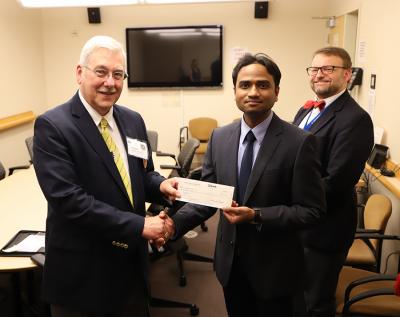
James W. Golladay Jr., department commander of the Knights Templar Mid-Atlantic Department (left), presents check to Aman George, Ph.D. (center). On the right, Brian P. Brooks, M.D., Ph.D., NEI clinical director, chief of the Pediatric, Developmental, and Genetic Ophthalmology Section, looks on.
National Eye Institute (NEI) Postdoctoral Fellow Aman George, Ph.D., has received a $65,000 grant from the Knights Templar Eye Foundation to identify new drug treatments for vision impairment in children with a type of albinism. George is a researcher in the NEI Pediatric, Developmental, and Genetic Ophthalmology Section.
George has developed a “disease-in-a-dish” model system that replicates the retinal pigment epithelium (RPE), a tissue layer in the back of the eye that supports light-detecting photoreceptors. For people with albinism, who produce little or no pigment, low pigment levels in the RPE lead to vision problems.

From left to right: Spyridon G. Treklas, right eminent grand commander of the Maryland Knights Templar; Golladay; George; Brooks; and John Austin, eminent grand generalissimo of the Maryland Knights Templar.
One of the most common and severe types of albinism, oculocutaneous albinism, Type 1 (OCA1A), is caused by mutations in a gene crucial for making an enzyme called tyrosinase. Tyrosinase, in turn, is essential for producing pigment. People with OCA1A lack pigment in their skin, hair, and eyes. They typically have low vision that worsens during early childhood due to underdeveloped fovea, an area of the retina important for central vision, and defects in the optic nerve—the bundle of nerve fibers that carries signals from the eye to the brain. Scientists think the RPE may help form the fovea, but they don’t know exactly why or how loss of pigment in the RPE disrupts this process.
Using stem cells derived from the skin cells of patients with OCA1A, George is able to grow pigment-less RPE cells in a dish. With the funds from Knights Templar Eye Foundation, he plans to use these cells to search for drugs that can overcome tyrosinase defects. Ideally, his research will yield a drug to help patients with OCA1A produce RPE pigment, which could help the eye develop normally.

Aman George, Ph.D.
“With this grant from the Knights Templar Eye Foundation, we hope to understand the defects at the molecular level in the RPE cells that contribute to vision defects in people with albinism. We will also perform drug screening to identify molecules that can rescue pigmentation, with the ultimate goal to restore visual function,” said George.
The Knights Templar Eye Foundation is a charity sponsored by the Grand Encampment of the Knights Templar that supports pediatric ophthalmology research. Their career-starter grants are awarded to early-career researchers like George with projects that potentially yield treatments for vision problems in children. This is the second such grant awarded to an NEI trainee in the past three years.
“The Knights Templar are proud to support research like Dr. George’s work on pediatric eye diseases,” said James Golladay, department commander of the Knights Templar Mid-Atlantic Department. “Presenting these awards to young scientists; knowing what kind of difference this grant can make…it doesn’t get any better than that!”